 |
Figure 1. Index map of Long Island Sound study area (H11446), U.S. Geological Survey (USGS)/Connecticut Department of Environmental Protection (CT DEP) surveys, and National Oceanic and Atmospheric Administration (NOAA) hydrographic surveys. NOAA hydrographic surveys include: H11250--Poppe and others (2006c, 2007b); H11255--Poppe and others (2006b); H11252/H11361--Poppe and others (2007a, 2008); H11043--Poppe and others (2004); H11044--McMullen and others (2005), Poppe and others (2006a); H11045--Beaulieu and others (2005); H11251-- Poppe and others (2010); H11445--McMullen and others (2010); H11997--Poppe and others (2011). USGS/CT DEP sidescan-sonar surveys include: Norwalk--Twichell and others (1997); Milford--Twichell and others (1998); New Haven Harbor and Central Long Island Sound (CLIS) dumping grounds--Poppe and others (2001); Roanoke Point--Poppe and others (1999b); Falkner Island--Poppe and others (1999a); Hammonasset--Poppe and others (1997); Niantic Bay--Poppe and others (1998b); New London--Lewis and others (1998), Zajac and others (2000, 2003); Fishers Island Sound--Poppe and others (1998a). |
 |
Figure 2. Map showing the location of end moraines (black polygons) and submerged moraine line (dashed lines) in southern New York and New England (modified from Gustavson and Boothroyd, 1987). The Ronkonkoma-Block Island-Nantucket end moraine represents the maximum advance of the Laurentide Ice Sheet about 20,000 years ago, and the Harbor Hill-Roanoke Point-Charleston-Buzzards Bay end moraine represents a retreated ice-sheet position from about 18,000 years ago (Uchupi and others, 2001). |
 |
Figure 3. The National Oceanic and Atmospheric Administration Ship Thomas Jefferson. |
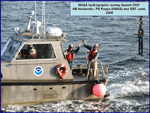 |
Figure 4. The National Oceanic and Atmospheric Administration launch 3101 with able seaman Haulander, physical scientist Poppe, and senior survey technician Lewit aboard. |
 |
Figure 5. RESON SeaBat 8101 used to collect bathymetric data on National Oceanic and Atmospheric Administration launch 3102 during survey H11446. |
 |
Figure 6. RESON SeaBat 8125 used to collect bathymetric data on National Oceanic and Atmospheric Administration launch 3101 during survey H11446. |
 |
Figure 7. Klein 5000 hull-mounted to National Oceanic and Atmospheric Administration launch 3102 to collect sidescan-sonar data during survey H11446. |
 |
Figure 8. The U.S. Geological Survey R/V Rafael used to collect bottom photographs and sediment samples on cruise 2010-010. |
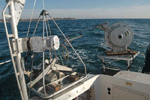 |
Figure 9. The small SEABed Observation and Sampling System (SEABOSS), a modified Van Veen grab sampler equipped with still and video photographic systems, mounted on the aft starboard side of the R/V Rafael. The system uses a winch, mounted on a davit (left), and a take-up reel for the video-signal and power cable (right). |
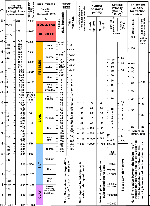 |
Figure 10. Chart showing the relations among phi sizes, millimeter diameters, size classifications (Wentworth, 1922), and American Society for Testing and Materials and Tyler sieve sizes. Chart also shows the corresponding intermediate diameters, grains per milligram, settling velocities, and threshold velocities for traction. |
 |
Figure 11. Sediment-classification scheme from Shepard (1954), as modified by Schlee (1973). |
 |
Figure 12. Hill-shaded multibeam bathymetry from National Oceanic and Atmospheric Administration survey H11446. Warmer colors (reds) are shallower areas; cooler colors (blues) are deeper areas. Boxes show locations of figures 14 and 15. Sand-wave profiles are shown in figure 16. |
 |
Figure 13. Interpretation of sea-floor features in the multibeam bathymetry and sidescan-sonar imagery from National Oceanic and Atmospheric Administration survey H11446. |
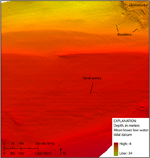 |
Figure 14. Detailed multibeam bathymetry image in the western part of the study area showing sand waves and a hummocky sea floor with boulders. The sand waves have 10- to 20-meter wavelengths. Location of image shown in figure 12. |
 |
Figure 15. Detailed multibeam bathymetry image in the north-central part of the study area showing sand waves with branching crests and boulders with scour marks. Scour on the western side of the boulders indicates westward-flowing bottom currents. Location of image shown in figure 12. |
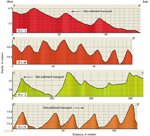 |
Figure 16. Sand-wave profiles of waves in the study area. Profiles A-A' and C-C' show sand waves with asymmetries that indicate net sediment transport to the west. Profile B-B' shows relatively symmetrical sand waves. Profile D-D' shows sand waves with eastward net sediment transport. (VE, vertical exaggeration.) Location of profiles shown in figure 12. |
 |
Figure 17. Sidescan-sonar imagery from National Oceanic and Atmospheric Administration survey H11446. Lighter tones represent high backscatter and are interpreted as coarser grained material, such as gravel, which is capable of reflecting more of the sonar waves. Darker tones represent low backscatter and are interpreted as finer grained materials, such as sand. Boxes show locations of figure 18 and figure 19. |
 |
Figure 18. Detailed sidescan-sonar image of boulders with scour marks at the eastern end of the study area. Scour depressions to the east of the boulders indicate net eastward bottom currents; higher backscatter in the depressions indicates the presence of coarser grained sediments. Dark stripes in the middle of sonar lines are nadir gaps. Location of image shown in figure 17. |
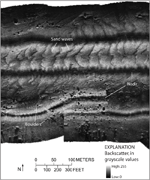 |
Figure 19. Detailed sidescan-sonar image of sand waves and boulders at the eastern end of the study area. Tiger-striped pattern in the sonar image indicates sand waves, and high-backscatter targets with low-backscatter shadows are boulders. Dark stripes in the middle of sonar lines are nadir gaps. Location of image shown in figure 17. |
 |
Figure 20. Location of sediment samples collected during R/V Rafael Cruise 2010-010 north of Orient Point, New York. Warmer colors (reds) represent coarser grained sediment. |
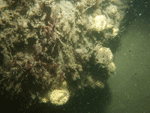 |
Figure 21. Photograph of the sea floor at station OP9 showing a boulder encrusted with sponges, hydrozoans, and seaweed. Location of photograph shown in figure 25. |
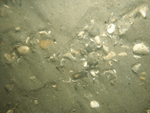 |
Figure 22. Photograph of the sea floor at station OP13 showing current-rippled sediment with gravel and shells concentrated in the ripple troughs. Location of photograph shown in figure 25. |
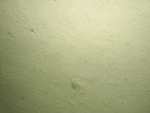 |
Figure 23. Photograph of the sea floor at station OP22 showing the burrowed sandy environment. Location of photograph shown in figure 25. |
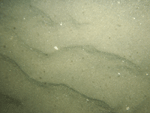 |
Figure 24. Photograph of the sea floor at station OP12 showing sand waves. Location of photograph shown in figure 25. |
 |
Figure 25. Location of bottom photographs taken during R/V Rafael cruise 2010-010 north of Orient Point, New York. |